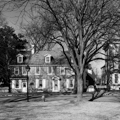William Penn called for a market square in Dover, but one was not laid out until c. 1720, on either side of S. State Street. Revolutionary soldiers are said to have mustered here. Since the 1840s, it has been a park. Many of its trees are unusual specimens or were planted to mark an occasion. The tall elms (1849) were a favorite subject for postcards; a survivor is the secondtallest tree in the state at 136 feet, after a tulip poplar at Winterthur (CH10.7).
In recent years, residents defeated a plan to close the area to traffic and remodel buildings back to a “colonial” appearance as “Constitution Place” (1986–1987, Norman Day Associates). Many attractive old houses surround the Green, the whole forming a delightful, storybook ensemble not to be missed. The big, brick Greek Revival house at Number 10 was built c. 1854 for Sally A. Sipple (see also KT20). The State Historic Preservation Office at Number 15 is the former Henry Todd House (1859), a tall brick dwelling with marble steps and watertable; a print shop was added at the side. Number 16 is one of Delaware's best cottages, influenced by the mid-nineteenth-century designs of Andrew Jackson Downing, with vertical boarding and a Gothic Revival porch. The Century Club (Number 40, remodeled 1897) is a good example of early Colonial Revival in brick with a big Palladian window inserted into what originally was a church. The tiny frame office building at Number 49 served as Dover's first post office and, later, a law office. The brick Kent County Courthouse (c. 1875) was reconstructed in Colonial Revival in 1918, supposedly by Philadelphian Wilson Eyre. In 2003, the county left the Green for a new facility on U.S. 13 (Becker Morgan Group).
Writing Credits
If SAH Archipedia has been useful to you, please consider supporting it.
SAH Archipedia tells the story of the United States through its buildings, landscapes, and cities. This freely available resource empowers the public with authoritative knowledge that deepens their understanding and appreciation of the built environment. But the Society of Architectural Historians, which created SAH Archipedia with University of Virginia Press, needs your support to maintain the high-caliber research, writing, photography, cartography, editing, design, and programming that make SAH Archipedia a trusted online resource available to all who value the history of place, heritage tourism, and learning.




